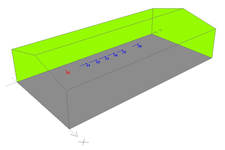A workshop is a space in which numerous and varied sources of noise can often be identified: machinery and machining centers, production lines, ventilation and dust removal equipment, manual work with portable tools.
 |
All these noise sources contribute, sometimes to varying degrees, to the acoustic environment of the various workstations, for which the sound pressure level (commonly known as sound level) should remain within acceptable limits in relation to hygiene and safety, since it comes to the health of those who are there for prolonged periods: the exposure limit values for workers in France are a daily level of exposure to noise from 87 dB (A) or a peak sound pressure level of 140 dB (C).
The room plays a role, with respect to the acoustic environment in a workplace, that should not be neglected, since the presence of walls opposes the sound propagation to the outside and therefore increases the sound level inside, in relation to the phenomenon of reflection and sometimes diffraction of the sound on the walls (at the origin of the phenomenon of reverberation): to the direct acoustic field (equal to that which would be generated in a space unlimited) is then added (it is the specificity of a closed space, even partially) a reverberated acoustic field.
In order to comply with the regulatory text applicable in France (the Order of 30 August 1990 on the acoustic correction of work premises), a workshop must (as a building) have an intrinsic acoustic performance such as the decay of the noise level by doubling the distance to the source, measured according to the context either in the empty room of any machine or production facility, or after installation of the machinery and production equipment reaches at least a minimum value, variable from 2 to 4 dB (A), according to its floor area.
If they are not measured (at least with a sound level meter) to characterize the existing situation, or in the case of a project to improve an acoustic environment in a company (soundproofing action plan), an acoustic study of a workshop makes it possible to predict these indicators (on the one hand: the noise level in different locations of the premise and on the other hand the spatial sound decay) for different scenarios of acoustic correction i.e. considering more or less important quantities of materials, more or less absorbent depending on the frequencies to consider, positioned on the walls and under roof (e.g. suspended ceiling with absorbent tiles) or by the means of acoustic screens.
Whether analytical methods or simulations based on ray tracing, a sound source and several receivers are considered for such forecasts by ITS, for which the atmospheric absorption is not always negligible for calculations sufficiently accurate e.g. in the case of large premises.
An acoustic study of a workshop makes it possible to predict the noise level and the spatial sound decay.This is useful in the context of the prevention of employee noise exposure, which is often impacted by the acoustic performance of the building, which may need to be improved to allow better working conditions.